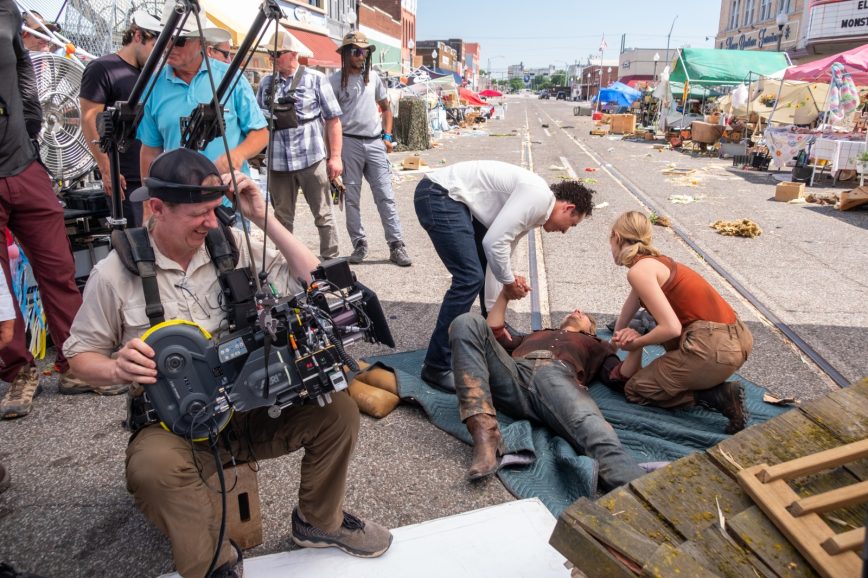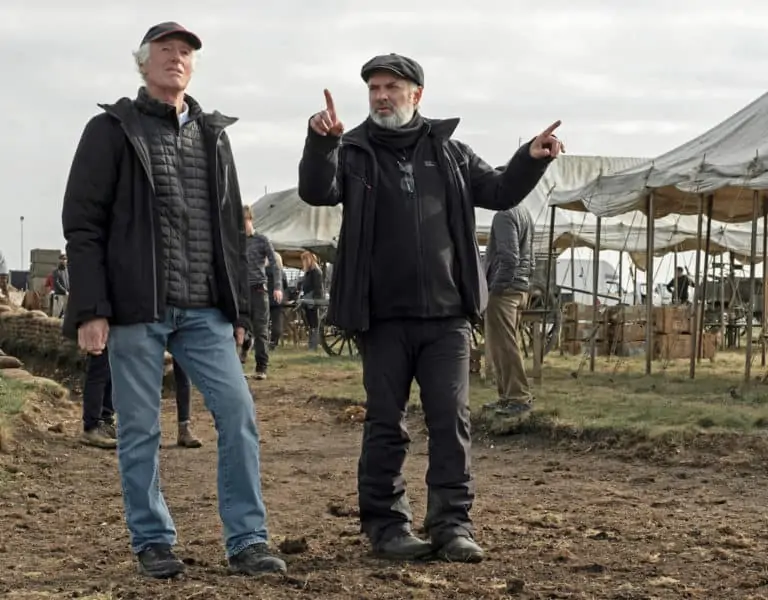WHIRLWIND ADVENTURE
When filmmaker Lee Isaac Chung made the leap from indie filmmaking to tornado hunting blockbuster territory with Twisters, DP Dan Mindel ASC BSC SASC’s experience making action-packed movies combined with Chung’s aptitude for seamlessly blending dialogue into the mix helped them capture the perfect storm.
Lee Isaac Chung admits directing this summer’s action blockbuster Twisters – a standalone sequel to 1996’s tornado chasing adventure Twister – signifies a major transition. It’s quite a departure from Minari, the 2020 indie hit he wrote and directed about a Korean American family move to an Arkansas farm in search of the American dream.
Before making predominantly low-budget, independent films, Chung grew up in Northwest Arkansas on the Oklahoma border. “Tornados were a big reality for me… As a child, I was mesmerised when the original film came out in 1996. Here was a group of people running into the storm while everyone else was running out,” he says. “So, when the producers came to me to direct this new chapter, I was truly honoured and terrified to make the transition into tentpole, summer blockbuster territory. But the film embodies what inspired me to take on the challenge; I wanted to run toward my fears and not away from them.”

As well as presenting the chance to work alongside “industry titans” Steven Spielberg (executive producer) and Frank Marshall (producer), Twisters allowed Chung to realise his dream of telling a story with a strong, female lead. This was embodied in Kate (Daisy Edgar-Jones), a retired tornado-chaser and meteorologist persuaded to return to Oklahoma to work with a new team.
When Dan Mindel ASC BSC SASC was approached to lense the film he was keen to talk to Chung because, “like millions of other people,” he thought Minari was “a very interesting film”. Following a “marathon” first conversation in which they engaged immediately, Chung’s pitch intrigued Mindel because “the director wanted to shoot on location and use as many in-camera effects as possible”.
“I’m a big advocate of that, although many movies I’ve shot are not all in camera. A lot of are VFX-heavy [such as J.J. Abrams’ Star Wars: Episode VII – The Force Awakens],” says Mindel. “I’ve made it my business early on to understand how all of that works, and how to amalgamate VFX with analogue filmmaking.”
Having shot a number of big action films including Mission: Impossible III, Mindel believed that was partly why the producers wanted him on board. “But as we started making the movie, it became apparent that as a filmmaker, Isaac’s power is not only in dialogue, it’s in his unique interpretation of how the action and dialogue intertwine, interpreting the story in a fun meaningful way.

“So many people are capable of making action movies, but they don’t have the all-round ability to shoot dialogue in a non-expositional way. Exposition has become the roadmap for so many movies but Isaac layered it all together and made the dialogue and action really engaging.”
Mindel and Chung decided early on to capture the environment in widescreen 2:39 anamorphic framing, using a photographic look and feel reminiscent of ’60s and ‘70s time life photographic style. “We wanted to encapsulate the Americana of it all and present the heartland of the country in a positive way,” says Mindel. “We tried hard to keep it in a period style too rather than purely contemporary and for scenes such as those at the rodeo we achieved this through wardrobe and vehicles.”
References included Westerns, road movies and films capturing a mid-century, rural America vibe, mostly from the Golden Age of Hollywood. One exception was 1971’s The Last Picture Show (Dir: Peter Bogdanovich). “It was a black-and-white movie, but set in the middle of the country, northern Texas,” he says. “It was steeped in the kind of Americana we were looking for in Twisters, nostalgic yet modern, affectionate but not naïve.”

Focus and discipline
When Chung expressed an early interested in shooting on film, Mindel was excited to be part of that creative journey throughout which he considered the effect celluloid would have on locations and sets by spending time with the art department ensuring their textures and palettes worked for the camera crew.
“I was trained to appreciate that dailies become the information dispersal point for all departments,” he says. “But I’ve done movies where no one goes to dailies except camera and the director which I find amazing as makeup and other departments should refer to dailies to tweak what they’re doing as they go.
“On modern sets, you have so many monitors and people assume that’s what the movie will look like. So on this film I tried to minimise the number of screens because they’re pointless as a guide when shooting analogue because the video assist is not what people are used to looking at. They’re used to looking at high tech renditions of what the camera is seeing but that’s really not what we’re doing.”
Therefore a theatre was built at the studio for dailies so Mindel, production designer Patrick Sullivan, and all heads of department could see what the film looked like once it had been processed. Film was sent from Oklahoma to FotoKem in LA to be processed, and received by Mindel two days later. “As this is a location movie and we were on the move every day, we had little opportunity to repair anything two days later, but shooting on film definitely played a positive role in the process as the set becomes highly disciplined,” he says. “It requires the camera to cut between takes which gives everybody a chance to reset and make adjustments if needed which encourages focus.”
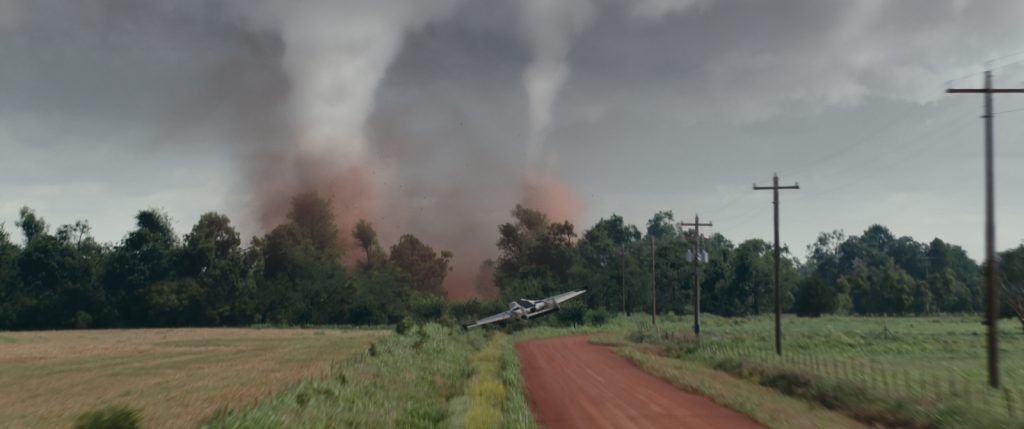
Like Chung, Mindel wanted to shoot on film due to the tone and colour it produces. “The tactile nature and colour rendition of film allows us to capture the ambience and texture of Oklahoma, giving it a fabulously rich and satisfying look, plus an added grit, which adds to the visceral presentation of the action, and is really aesthetically pleasing.
“But aesthetics aside, the resolution allows more cheating with the backgrounds and what is discernible on the screen. When you look at dailies, you can see the influence turning the light down a bit in the background or moving the focus has had on the picture. That latitude in terms of the texture is something I don’t think you can do digitally and is what gives analogue movies an advantage in storytelling because they become highly texturised and engaging rather than looking at high detail.”
Liking to minimise the number of options, Mindel wanted to shoot Ektachrome but could not find a lab offering the process he wanted in the US. “We shot some Ektachrome but the main stocks were Kodak Vision3 500T 5219, 50D 5203, and 250D 5207. Shooting anamorphic requires a bit more stop on film than digital, so I needed a slightly faster stock for the car interiors which was the 250D 5207 to give us a bit more focus.”

On the road to success
Prep took place between April and June, much of it at Universal Studios in LA where all physical effects were tested and camera prep was carried out so the two aspects could be mixed together. The team then travelled to Oklahoma to build the effect stages for the process work – one interior and one exterior – at ice hockey arena Prairie Surf Studios which the team took over to create a large green and blue screen stage.
Around 20% of the film required process work at the stage as some sequences could not be controlled. But Mindel tried to shoot as much as possible in real cars on the road which he admits “could be a challenge and takes a lot of dedication and people to make it work”. He didn’t use virtual production because he found when shooting with analogue cameras, “the pixels in the screens show up and the additional budget was not available”.
To source driving footage for scenes shot in the studio, VFX supervisor Ben Snow contacted motion environment and stock driving footage provider Driving Plates. Mindel then helped plan the plates shoot with the Driving Plates team including CEO Shawn Lawler.
Their brief was a breakdown of different vehicles, lens heights, cross referenced with time of day, and then ordered by location to minimise travel around Oklahoma state. Driving Plates worked on the production for around five weeks, shooting with RED Komodo cameras on their all-wheel drive BMW 5 series saloon for sequences of driving through fields and for tornado chaser Tyler’s (played by Glen Powell) truck. They also mounted on a Jeep Cherokee to match the height of the larger vehicles such as the TRX and RV for jumps and stunts.
One of the unusual aspects of the production was the large amount of off road driving, much of it at high speed. “We made some modifications to the array which we have since rolled out to all our offices around the world that gives gyrostabilised results without using an actual gyro, which adds significant height to the set-up,” says Lawler. “We could still mount onto a standard vehicle, very often with stunt team drivers at the wheel for fast road and off road sequences, and often going from one to the other.”
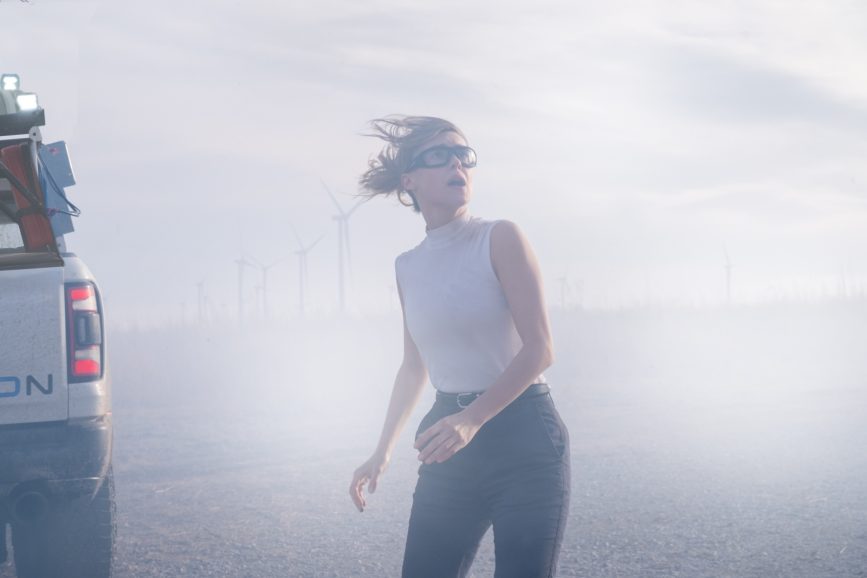
When navigating sometimes inflexible schedules of commercial filmmaking and location shoots, Mindel highlights amalgamating good weather with bad as an important part of the process. “It’s about how to mitigate the sun when you don’t want it or put it in when you want it and it’s not there. And with a script like this, which calls for two or three diverse locations, it’s quite simple to make it all work with what we have in the environment we’re in.”
Oklahoma’s unpredictable weather led Chung and Mindel to shoot under overcast skies to maintain continuity, unless blue skies were called for in the script. And when the weather turned very stormy – just the conditions required – it was difficult for Mindel and Chung to shut down filming, even though it was necessary in terms of safety. “Yet it’s counter-instinctual for me to stop shooting for any reason, especially when you’re making a film when the exact type of weather you want for a movie about violent storms is rolling in!” says Mindel. “It was upsetting for me and for Isaac when we had to shut down and shelter in place just as the sky was getting spectacular.”
When trying to capture stormy scenes in sunny conditions, cranes with negative fill were used to reduce the hard light on the foreground and actors. Light was then bounced in and the camera crew let the background go out of their control and ILM take over when necessary. “When you’ve worked a lot in Europe as a DP, especially northern Europe, you don’t contend with the sort of sun to cloud ratios found in Middle America, but having lived and worked in the US a lot and done location movies there, I’ve learned a lot from the American school of location lighting and grid work. So we were pretty well equipped to manipulate the onset lighting.”
A significant issue affecting the film’s continuity was the writers’ strike which took place in the middle of shooting the biggest sequence, forcing the crew and cast to wrap between July and December 2023. When they returned to Oklahoma – where most of the film was shot – in December, the environment had changed with the season. “We were compelled to finish what we had started and made it work so when you look at the movie, you can’t really tell,” he adds.
When shooting a location movie, every day the team encounter a new place. While travelling all over rural Oklahoma, the crew shot in many “nondescript” country roads (with the exception of Downtown Oklahoma which doubled for New York in sequences when Kate is between storm chasing expeditions). “Oklahoma is very flat and that could be boring, but it helped us because it meant we could really blend many locations into one,” says Mindel. “So many movies now just get made on flat ground at the studio, so it was quite a learning curve for many of the younger crew which is fantastic.”

Stripped back
Twisters was shot on a mixture of 35mm cameras – the Arriflex 435, 235, and 535B, and Panaflex Millennium XL2 – which Mindel commends for being “reliable and as they are around 20 to 30 years old, everybody has worked out all the bugs”. Frequently using the same Panavision lens package, the cinematographer asked Panavision’s Dan Sasaki to set Primo Anamorphic close focus lenses back to factory settings. Having “become overwhelmed by how many tweaks people make to lenses to mess with the image”, he wanted to manipulate the image in camera instead.
As well as primarily working with the Primo Anamorphics, Mindel used Panavision T-Series Anamorphics (for Steadicam and handheld), and the Retro C-Series lenses which were made for him some years ago and were well suited to landscape photography and widescreen filmmaking.
“I enjoyed seeing the movie in the DI when we were colouring it and seeing all the flaws that exist in the lenses and in the film,” says Mindel. “They give us an ambience I think is engaging and atmospheric in terms of layering the story.”
Having collaborated with Company 3 founder and CEO Stefan Sonnenfeld for 30 years, the process in the grade did not change on Twisters. “When he does a pass, he knows what I’m looking for in the image,” says Mindel. “Refinements generally relate to the visual effects and ILM VFX supervisor Ben Snow was with us most of the time so he could see how they were dialing it in. That’s one of the most fun parts of the process, seeing how it all comes to life on the screen. ILM has become so succinct in what they do, you can rely on them to deliver high quality work.”

The Twisters VFX team was dealing with “real atmospherics and weather opposed to spaceships and aliens”, highlights the cinematographer, “so the mathematics involved in making clouds and rain is a bit more regimented and because everybody knows what a cloud looks like, the digital artists have to step up their game”.
Working closely with visual effects supervisors over the decades, Mindel appreciates the importance of giving them as much flexibility in post as possible, rather than being dogmatic about photography in the initial stages. “The narrower the photography, the fewer options they have to undo what we do. It’s a symbiotic relationship. But that being said, often it’s the camera department – who get dirty and work in the wind and rain – who understand what the camera sees and doesn’t see. So VFX in turn rely heavily on us for the physical part of the process.”
Celluloid capture gave the VFX team more latitude to dial effects into the world being filmed. “It worked really well and I like to facilitate everything they asked for in return for forgiveness when I have a bright yellow 300-tonne crane that can’t move out of shot and ask them to help me get rid of it.”
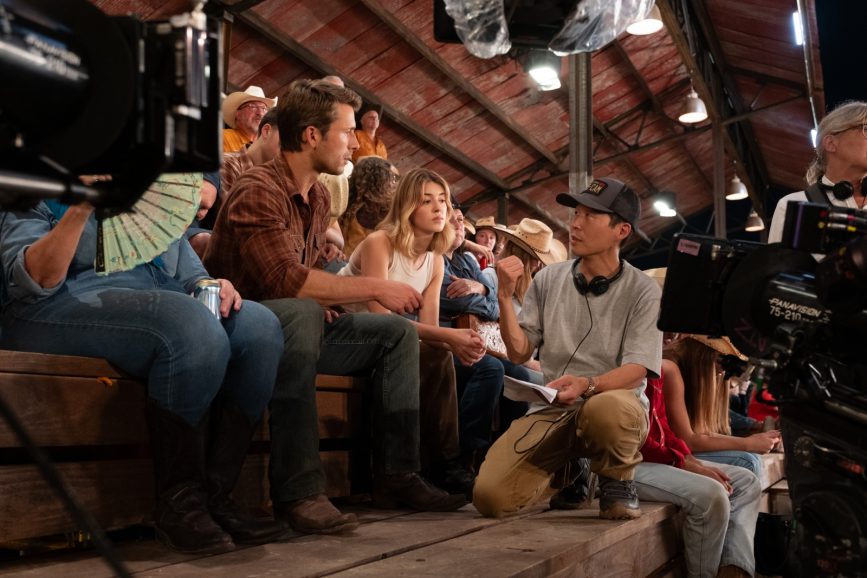
Magic and masterclasses
Mindel always works with a Steadicam operator as his A camera operator – who on this occasion was Geoffrey Haley SOC – to achieve continuity between Steadicam, handheld, and the standard camera. “We tried to keep everything within the period we were emulating and the majority is handheld and Steadicam as Geoff is such a master of it,” says Mindel. “I tried to keep quite low key camera movement, so it’s not locked off. I like a little bit of movement but we also had Geoff tied to the hood of the car, shooting some sequences handheld.”
When choosing the second unit director of photography, Mindel wanted a DP/camera operator who also knows how to shoot Steadicam, leading him to bring Chris Haarhoff on board to head up the second unit which captured many driving sequences that took place far away from the studio in Oklahoma.
“I rarely look through the camera as I trust in the operators and try to keep out of the way to give them complete autonomy to do what they like as long as it’s in keeping with the look,” says Mindel. “We collaborate on the conceptual part of the film but well-seasoned camera operators bring magic of their own to the production.”
Serge Nofield – with whom Mindel has worked with for many years – was once again pulling focus. “He’s one of the most important people on set because not only is he a master focus puller, he knows everything I’m going to need equipment wise.”

Dimming and remote control technology offered a manageable way to work with lighting and camera equipment on moving vehicles. And as the wind-driven rain the team often encountered is not a friend of cameras and lenses it was important to protect equipment. “It can be catastrophic if water gets in kit and we lost a few cameras to water damage. I hate to break anything, especially older equipment which is irreplaceable, so we tried very hard to protect cameras and lights by placing them in plastic bags and securing with rubber bands,” says Mindel. “Any time you bring technology to location filmmaking where there’s rain, sleet, snow, it’s can be a recipe for disaster. But we’re dealing with technical situations like that all the time, it’s part and parcel of what we do.”
To film the action from multiple viewpoints, the team relied on drones, helicopters, cranes, pursuit cars, biscuit rigs, dollies on tracks, Steadicam and handheld. The helicopter and drones featured 535Bs, adapted for the mounts and saw the team work with aerial DP Hans Bjerno.
“The helicopter is such a sturdy platform, you can use much longer lenses on the rig and so that’s how we did close-up tracking shots,” says Mindel. “The drone was a much more second unit frenetic part of that and was dictated by fact there were often power lines all over the place, meaning it wasn’t feasible to use the helicopter.”

The art of the storm
Twisters marked the first time Mindel had worked with John Vecchio, a gaffer who he believes “understood the lighting aesthetic” the cinematographer “wanted to achieve, using analogue fixtures wherever possible” which he finds “more endearing than digital lights”.
Vecchio was impressed by the scale of what Chung wanted to achieve and realised it would be the gaffer’s largest project to date. “I was also taken with the smaller, more intimate moments of human connection in the script and the chance to work on a project with both large scale effects and quite personal moments,” he says.
Vecchio was aware of Mindel’s extensive list of credits on movies he loved, “bolstered by his reputation as a wonderful cinematographer and collaborator” from several of his fellow gaffers.
Mindel’s methodology is “movie stars need movie star lighting”. That demands finessing the close-ups which required Vecchio to “carry every kind of soft light and be able to position and diffuse them”. The DP adds: “Some might think it looked like a pretty archaic procedure – we had 12 lights, 20Ks, Dinos and all the incandescent lights we could use, plus all big HMIs. But that’s not to say we didn’t have any digital lights – we used a lot of digital waterproof fixtures for extensive night set-ups such as the rodeo and motel sequences.”
After learning Twisters would be shot on film, Vecchio discussed the lighting fixtures Mindel liked to use and the ways they could combine the “gorgeous look of traditional tungsten lighting with the colour control and weather resistance of the newer LED lighting”. It was important to Mindel that when lighting actors’ faces traditional tungsten and HMI Fresnel fixtures were used and LED fixtures were saved for tasks like overhead soft boxes, blue screen lighting, and instances when they needed to change colour and intensity during a scene.
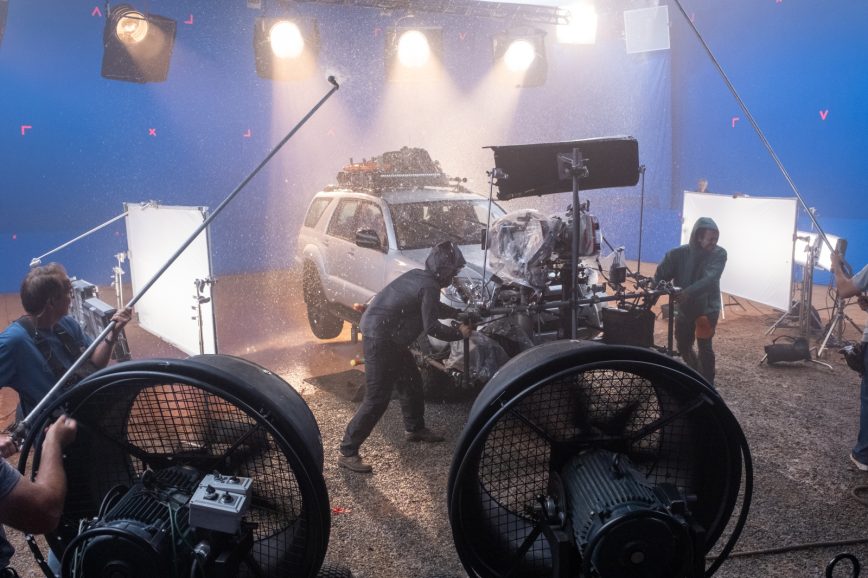
Vecchio and Mindel share a love of the look produced by large tungsten and HMI fresnels, especially when shone through large diffusion frames of silk, magic cloth, and muslin. “You obtain a wonderfully soft wrapping light which makes actors positively glow,” says the gaffer. “Dan is also a fan of the tungsten mole beam which we used to send concentrated beams of light through windows and openings to create a natural sunlight look.”
Mole beams were used to great effect in a sequence taking place in a barn. Combined with soft tungsten overhead boxes and warm practical fixtures, they achieved a romantic mood. “We also made use of the Mole Richardson 12 light Maxi-Brutes and used tungsten and dichroic globes which had a bit of blue to them for a subtle mix of warmth and daylight,” says Vecchio. “As for LED lighting, our favourite instruments were Creamsource Vortex8 fixtures and Astera Titan and Helios tubes. We used Vortex8s in all soft boxes on stage and incorporated them in our outdoor work because of their ability to function well in wet and windy environments.”
The Vortex fixtures’ “capacity to flash and strobe” saw them used frequently in the rodeo scenes and the Astera Titan tubes were “invaluable” for practical applications as outdoor lighting on the facades of the hotels as well as in situations where a little fill light was needed in the theatre sequences and in storm chaser cars. Both fixtures were wirelessly controlled by lighting programmer Jonathan Huggins, who changed intensity and colour temperature on the fly, allowing Mindel to make subtle changes while shooting.
When working with natural light, Vecchio and Mindel’s mantra was to “embrace the environment and augment with large bounces and the occasional eye lights for actors”. Key grip Joseph Macaluso provided Mindel with large diffusion frames mounted on Pettibones to cover larger outdoor areas, particularly over the vehicles. “Joseph and his fantastic crew also provided the rigging required to mount lights and generators on vehicles to light actors while they were in motion – a tricky proposition considering the rough roads and practical special effects such as wind, dust, rain and hail the special effects crew were dumping on the vehicles as they drove,” says Vecchio. “Joseph and his crew helped our electricians protect the lights from the elements by wrapping the heads with weatherproofing material and reinforced frames and metal flags.”
Vecchio and Mindel single out the rodeo and adjoining motel sequences as the film’s most challenging set piece. The art and locations department found an existing motel with a large empty field across the highway and constructed a portion of the motel that would be destroyed in the tornado as well as a grandstand at the rodeo site which would be destroyed. “Isaac’s concept for the nighttime scene was that the rodeo would be disrupted by an approaching tornado, causing a blackout and sending the area into chaos,” says Vecchio. “His desire once the blackout occurred was that the rest of the scene be illuminated by lightning. It was easily the biggest and most challenging lighting situation I’ve encountered.”

To achieve this they surrounded the rodeo and motel with 14 large cherry pickers, each one rigged with three 12 light Maxi Brutes and a large lightning machine. A Bebee Light 15-light array, three condors with two 18K LRX movers and four Pettibones with five Vortex8 and two moving lights on each were also added into the mix.
“This rig enabled us to have a powerful backlight in whichever direction we shot as well as the ability to provide massive lightning once the blackout occurred. We used four Super Troupers on scaffolding to light the rodeo and set construction installed telephone poles around the rodeo rigged with Mini Brutes and par cans,” explains Vecchio. “On top of this Titan Tubes were in every merchandise tent and long strings of carnival lights festooned about the area.”
All practical lights and Condors in the set-up were controlled by lighting programmer Huggins, enabling the team to affect the blackout and create a storm of lightning. “Our incredible rigging crew, led by Luis Moreno, overcame challenges including rivers of mud and schedule changes to provide an incredible set to shoot which performed flawlessly night after night.
“This adventure reinforced the importance of assembling a top notch crew, including my Best Boy Lukas Hencey, our awesome electricians, data department, fixtures team and of course the rigging crew.,” says Vecchio. “I felt comfortable and confident each day that we could support the vision of Dan and Isaac because of the hard work of all these amazing individuals.”
Mindel also learnt a lot from many crew members including camera operator Geoff Haley SOC whose process he compares to “a masterclass every day”. Some 40 years into this industry, Mindel is still “processing what other people are doing and discovering new techniques. It’s all about how to do things better than the time before to deliver the best movie possible”.
On this occasion the director-DP duo achieved just that with their trusty crew and, as Chung puts it, created a film “that aims to offer an exhilarating experience that transcends the confines of the screen… My hope is to ignite in audiences the same sense of wonder and awe that I felt as a kid witnessing the power of nature firsthand.”
